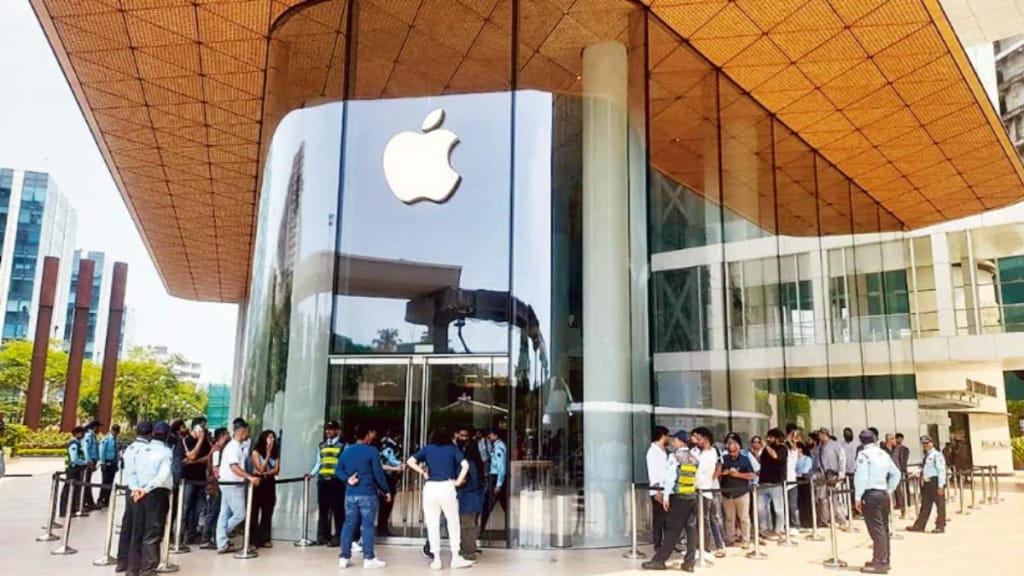The long queues and scuffles that marked the recent launch of Apple’s iPhone 17 are seldom seen during a product launch in India. For a device that is priced north of Rs 80,000, the iPhone frenzy is an oddity in India’s price-sensitive market. Apple might have made its retail foray in the country just over two years ago, but it seems the late entry has served to only fuel the hype around every iPhone launch.
This is where experts laud Apple’s marketing strategy. They say it has succeeded in making the sought-after iPhone more accessible and relevant to Indian consumers without diluting its premium brand image. According to industry estimates, Apple’s share in India’s Rs 4 lakh crore smartphone market has doubled from around 4% in 2021 to 8% as of September this year.
In keeping with its global strategy Apple’s marketing in the country has always been about creating aspiration before accessibility, says Rutu Mody Kamdar, founder of Jigsaw Brand Consultants. “Apple has nurtured this fandom through scarcity, ritual, and spectacle. In India, the iPhone is not a gadget; it’s “a badge of becoming”. It signals upward mobility, global belonging, and personal success; the three currencies that drive modern Indian aspiration,” notes Kamdar.
Apple is known for creating this false sense of urgency with its messaging around ‘limited stock’, fuelling a sense of FOMO (fear of missing out) among consumers in markets it sells its products. Observers attribute the long queues and eagerness to grab the newest model on day one to this strategy. In recent years, though the iPhone has managed to crack the fine balance between aspiration and accessibility, making it an attainable dream for India’s growing middle class, says Manav Parekh, EVP at Only Much Louder (OML).
It has gone beyond tech to become a lifestyle marker. “Apple feeds that perception with its celebrity pull, clean design and slick marketing. You will often find Apple’s iPhone or MacBook featured in international movies and TV series. The brand has been tapping into influencer culture and timing its launches just around the festive months, making each launch into a major event and not just another product unveiling,” says Parekh.
Poised for growth
Apple has also made purchase much easier with EMIs, trade-ins for old iPhones phones and locally assembled products that are cheaper but with the luxury halo intact. Parekh adds that since the phone has a high resale value, most consumers do not feel the pinch when trading in their old iPhone for the new one. The cost eventually works out to be similar to that of a premium Android device.
According to Cyber Media Research, sales for the iPhone in India grew last year at 23% and are likely to grow at 29% during this year. The country has become an integral part of Apple’s global supply chain, now exporting a significant share of iPhones produced locally, points out Prabhu Ram, VP – Industry Research Group at Cyber Media Research. “With an expanding network of suppliers and manufacturing partners, India is strengthening its role as a major production and export base—enhancing Apple’s supply chain resilience while deepening its presence in the domestic market,” says Ram.
Despite the iPhone fandom and Apple’s remarkable growth, Android devices continue to dominate the Indian smartphone market with over 95% share. Aditya Premani, co-founder & head of social at Social Pill notes that though Apple’s brand power and ecosystem will power its growth in the Indian market steadily in the coming years, India will continue to remain a predominantly Android market.
“Indian consumers are increasingly drawn to real innovation and form-factor shifts, something brands like Samsung have demonstrated with the Z Fold and Z Flip range. By contrast, Apple’s recent upgrades have felt more incremental. India remains price-sensitive and highly competitive, so unless Apple brings a leap in functionality or new categories, it will remain a premium niche player rather than a mass-market leader, albeit one with strong cultural influence,” observes Premani.


